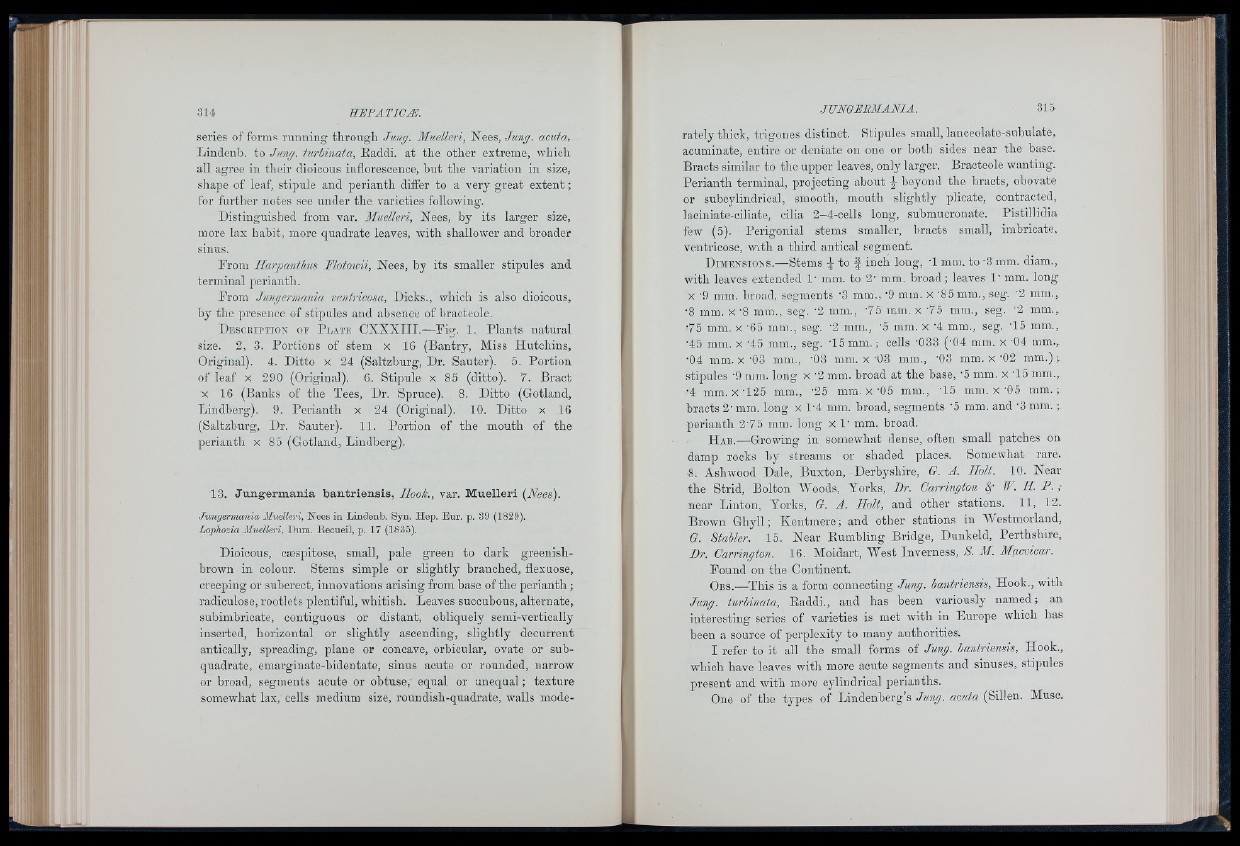
series of forms running through .Iimg. Muelleri, Nees, Jung, acuta,
Jjindenb. to Jung, turbinata, Eaddi. at the other extreme, which
all agree in their dioicous inflorescence, but the variation in size,
shape of leaf, stipule and perianth differ to a very great extent;
for further notes see under the varieties following.
Distinguished from var. Muelleri, Nees, by its larger size,
more lax habit, more quadrate leaves, with shallower and broader
sinus.
From IlarjKmfhus Flotoioii, Nees, by its smaller stipules and
terminal perianth.
From ,]ungermania ventricosa, Dicks., which is also dioicous,
by the presence of stipules and absence of bracteole.
D e s c r i p t i o n o e P lxAt e CXXXIII.~—Fip'. 1. Plants natural
size. 2, 3. Portions of stem x 16 (Bantry, Miss Hutchins,
Original). 4. Ditto x 24 (Saltzburg, Dr. Sauter). 5. Portion
of leaf x 290 (Original). 6. Stipule x 85 (ditto). 7. Bract
x 16 (Banks of the Tees, Dr. Spruoe). 8. Ditto (Gotland,
Lindberg). 9. Perianth x 24 (Original). 10. Ditto x 16
(Saltzburg, Dr. Sauter). 11. Portion of the mouth of the
perianth x 85 (Gotland, Lindberg).
13. Ju n g e rm an ia bantriensis, Hook., var. Muelleri (Nees).
.Tungermania Muelleri, Nees in Lindenb. Syn. Hep. Eur. p. 39 (1829).
Lophozia Muelleri, Hum. Eecueil, p. 17 (1835).
Dioicous, oæsjiitose, small, pale green to dark greenish-
brown in colour. Stems simple or slightly branched, flexuose,
creeping or suberect, innovations arising from base of the perianth ;
radiculose, rootlets plentiful, whitish. Leaves succubous, alternate,
subimbricate, contiguous or distant, obliquely semi-vertioally
inserted, horizontal or slightly ascending, slightly decurrent
antically, sqireading, plane or concave, orbicular, ovate or subquadrate,
emarginate-bidentate, sinus acute or rounded, narrow
or broad, segments acute or obtuse, equal or unequal ; texture
somewhat lax, cells medium size, roundish-quadrate, walls moderately
thick, trigones distinct. Stipules small, lanceolate-subulate,
acuminate, entire or dentate on one or both sides near the base.
Bracts similar to the upper leaves, only larger. Bracteole wanting.
Perianth terminal, qirojecting about J beyond the bracts, obovate
or suboylindrical, smooth, mouth slightly plicate, contracted,
laciniate-ciliate, cilia 2-4-cells long, submucronate. Pistillidia
few (5). Perigonial stems smaller, bracts small, imbrioate,
ventricose, with a third antical segment.
D i m e n s i o n s .—Stems I to f inch long, T mm. to '3 mm. diam.,
with leaves extended 1' mm. to 2' mm. broad ; leaves 1' mm. long
x '9 mm. broad, segments '3 mm., ’9 mm. x '85 mm., seg. '2 mm.,
8 mm. x -8 mm., seg. '2 mm., 7 5 mm. x 75 mm., seg. '2 mm.,
75 mm. x '65 mm., seg. ’2 mm., '5 mm. x '4 mm., seg. '15 mm.,
45 mm. x ’45 mm., seg. T5 mm.; cells '033 ('04 mm. x '04 mm.,
04 mm. X '03 mm., ’03 mm. x '03 mm., '03 mm. x '02 mm.) ;
stipules '9 mm. long x '2 mm. broad at the base, '5 mm. x '15 mm.,
•4 mm. X-125 mra., ’25 mm. x ’05 mm., T5 mm. x '05 mm.;
bracts 2’ mm. long x 1-4 mm. broad, segments '5 mm. and A mm.
perianth 275 mm. long x 1' mm. broad.
H ab.— Growing in somewhat dense, often small patches on
damj) rocks by streams or shaded places. Somewhat rare.
8. Ashwood Dale, Buxton, Derbj'shire, G. A. Holt. 10. Near
the Strid, Bolton AVoods, Yorks, Dr. Carnngton fl W. H. P . ;
near Linton, Yorks, G. A. Holt, and other stations. 11, 12.
Brown Ghyll; Kentmere; and other stations in AA'estmorland,
G. Stabler. 15. Near Bumbling Bridge, Dunkeld, Perthshire,
Dr. Carrington. 16. Moidart, West Inverness, S. M. Macvicar.
Pound on the Continent.
Obs.— T his is a form connecting Jung, bantriensis. Hook., with
Jung, turbinata, Eaddi., and has been variously named; an
interesting series o f varieties is met with in Europe which has
been a source o f perplexity to many authorities.
I refer to it all the small forms of .Jung, bantriensis. Hook.,
which have leaves with more acute segments and sinuses, stipules
present and with more cylindrical perianths.
One of the types of Lindenherg’s Jung, acuta (Sillen. Mnsc.